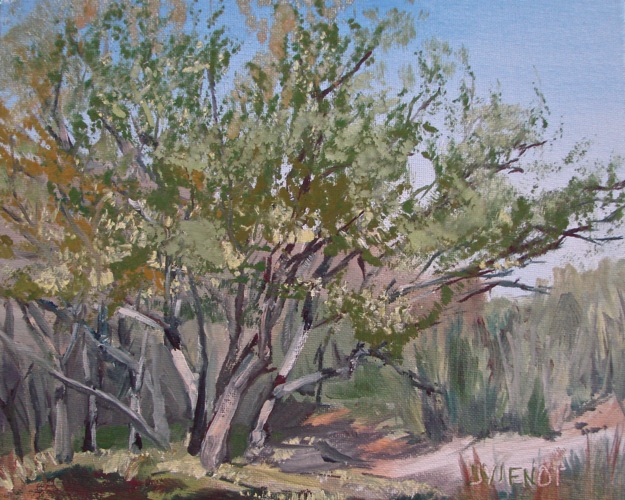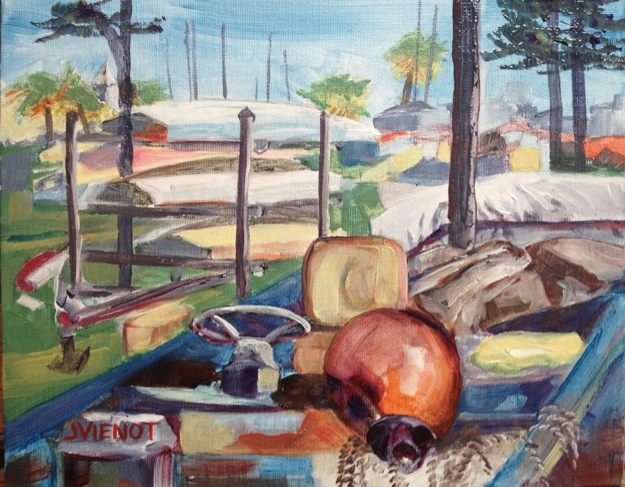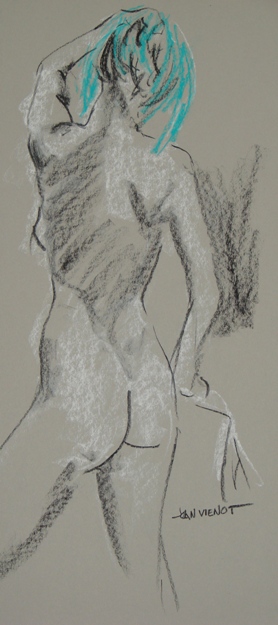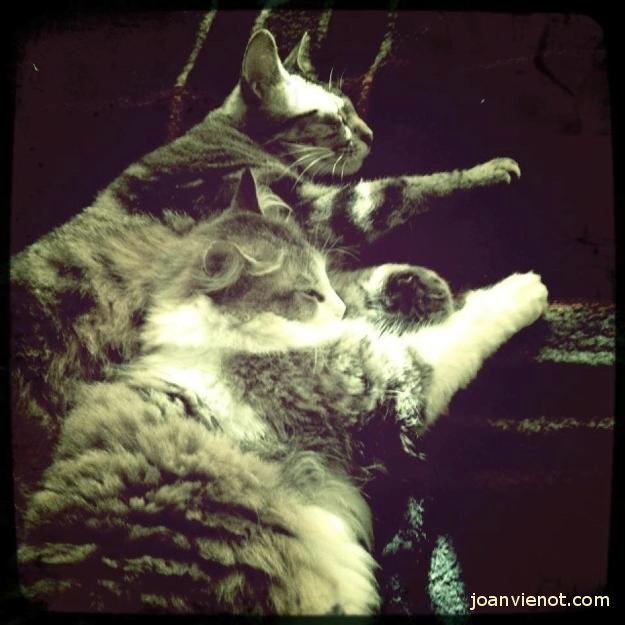Learning to See Better through Plein Air Painting

 Don Demers, one of my workshop instructors last week, tongue in cheek, said “Plein air painting creates bad drivers.” He explained the hazard, that as a practicing plein air painter, one could be driving along and become mesmerized, staring at the shape or color of something, perhaps even something so interesting as the shadow of an underpass. We all laughed of course, but I recognize the truth of his statement. After practicing plein air painting for 8 days, I can’t look anywhere now without noticing wonderful value contrasts, delicious color intensities, and patterns of light leading my eye through compositions waiting to be painted.
Don Demers, one of my workshop instructors last week, tongue in cheek, said “Plein air painting creates bad drivers.” He explained the hazard, that as a practicing plein air painter, one could be driving along and become mesmerized, staring at the shape or color of something, perhaps even something so interesting as the shadow of an underpass. We all laughed of course, but I recognize the truth of his statement. After practicing plein air painting for 8 days, I can’t look anywhere now without noticing wonderful value contrasts, delicious color intensities, and patterns of light leading my eye through compositions waiting to be painted.
The first workshop I attended was by invitation. Twelve painters were selected to be in the “pilot” course for the Apalachicola School of Art Plein Air Academy. Master plein air artist Don Demers is designing the curriculum, and Joe Taylor of the Apalachicola School of Art is planning the logistics. Together they will come up with a course to be offered as professional development for the advanced plein air painter. Don spent a good bit of time talking with each of us, as well as offering constructive tips with our paintings. Of most practical value to me was his suggestion to set intention before starting a painting, and then to stick to that intention. He suggested we draw “thumbnail sketches” of our intended paintings first, studying the value relationships and evaluating whether the composition would work as a whole, before we spent 3 hours painting it. Some of my sketches progressed into paintings, some were mere studies of shapes or ideas discarded as perhaps too complicated or logistically difficult (the one above left required me to stand in an ant pile; the one above right was too complicated for my limited knowledge of fishing boats).
I learned something about photography after doing one such value study, and that is that my iPhone camera does not see the light the way I do. In fact my camera hardly picked up the power of the light at all. Here’s a comparison:
 |
 |
I completed two paintings and a couple of studies in the Plein Air Academy workshop. Integrating what I am learning is always difficult — there has to be a period of intense, grinding focus, because painting is for the most part so visceral, and newly learned information so very intellectual. I found myself completely exhausted by the end of the first several days. I must have had every muscle in my body tensed as I tried to incorporate what I was learning. I literally came home, ate supper, and went straight to bed, for the first 3 days.
Here are a few of my paintings from the Apalachicola School of Art Plein Air Academy workshop.
 Typical page of notes Typical page of notes |
 |
 |
 |
 |
 |
Over the next few days I attended the Forgotten Coast En Plein Air event workshop with Greg LaRock and Ken Dewaard. I wish I could remember everything they said. It was fun to watch the different approaches of two accomplished artists. Both were very strong on compositional tips. LaRock often mentioned ways to lead the viewer’s eye through the painting, and Dewaard pointed out subtle color changes to look for, like the change in the tint of shadows depending on how much of the sky color they might be acquiring, or how much of the color of the ground. Hopefully I absorbed a lot of it, even though I can’t recite it. Below are the paintings I produced during their workshop. In the first one, my challenge was to make the pile of rubble, mostly chunks of concrete, look interesting, like a rocky shoreline. The paintings of the boats and of the shirts for sale both challenged me to simplify.
 |
 |
 |
 |
 |
I actually had energy to paint a few small studies outside of class, the last several days, below. Apologies for shooting the photos slightly crooked!
 |
 |
 |
NOTE: light added to 2nd painting above, at https://joanvienotart.wpengine.com/?p=7003
And now back to my day-job! But the shadows of those underpasses are starting to look mighty interesting!! |
























 Ugh! Boats again! Last week we met at a yacht club, and as much as I love sailing, and water sports of any kind actually, I certainly struggle when we paint boats. Parked in the middle of a giant circle drive were every kind imaginable of dinghies, sunfish, motorboats, rowboats, sailboats, you name it, in various stages of neglect and disrepair, to one side of the more manicured grounds and view of the docked yachts. I chose to paint the clutter. I wisely drew the shapes first, spending some time in what I imagined to be organization of geometric shapes, but that preparation did not keep me from getting lost in my own composition, numerous times. I was barely halfway done when fellow painter Sandra strolled past with her completed painting, and I asked her if she was going to do another, and she said, “Joan, it’s 11:00, it’s time for critique!”
Ugh! Boats again! Last week we met at a yacht club, and as much as I love sailing, and water sports of any kind actually, I certainly struggle when we paint boats. Parked in the middle of a giant circle drive were every kind imaginable of dinghies, sunfish, motorboats, rowboats, sailboats, you name it, in various stages of neglect and disrepair, to one side of the more manicured grounds and view of the docked yachts. I chose to paint the clutter. I wisely drew the shapes first, spending some time in what I imagined to be organization of geometric shapes, but that preparation did not keep me from getting lost in my own composition, numerous times. I was barely halfway done when fellow painter Sandra strolled past with her completed painting, and I asked her if she was going to do another, and she said, “Joan, it’s 11:00, it’s time for critique!”
 I am starting to see in color. That may sound strange, but the fact is that most of the time in my normal everyday activity, I hardly pay attention to color. When I was focusing on figure drawing, I occasionally used color, but for the most part I was focused on line, shape, and value, usually rendering the whole piece just using a black-white value scale. Now that I am painting again, I am noticing for example, when a white railing is picking up the blue of the sky, or how intense a green becomes when it is contrasted with red. I am finding that much of what I think I am seeing as different tones of a color are actually the same color which looks different depending on what color is next to it. I am particularly challenged by all the greens I see, when landscape painting. If I try to mix an exact shade of green, it often seems muddy compared to what I actually see. Who knew, that Einstein’s theory that everything is relative applies to painting as well as nuclear physics, that the better way to achieve a color is to find the color next to it which gives it the quality I want. Resisting the temptation to launch into that as a metaphor for life, I’ll instead move on to my adventures in plein air painting over the past week. Last week we painted at Nick’s Restaurant, and I bemoaned the fact that I know very little about boats. The next day I decided to take another run at the featured boat, using my photo references, and came up with the piece at top right. It was the little paprika-colored spots of rust washing out from the old nails in the hull, that gave the greens and turquoise the punch I wanted. So I wafted a little of that color into the foreground grasses too.
I am starting to see in color. That may sound strange, but the fact is that most of the time in my normal everyday activity, I hardly pay attention to color. When I was focusing on figure drawing, I occasionally used color, but for the most part I was focused on line, shape, and value, usually rendering the whole piece just using a black-white value scale. Now that I am painting again, I am noticing for example, when a white railing is picking up the blue of the sky, or how intense a green becomes when it is contrasted with red. I am finding that much of what I think I am seeing as different tones of a color are actually the same color which looks different depending on what color is next to it. I am particularly challenged by all the greens I see, when landscape painting. If I try to mix an exact shade of green, it often seems muddy compared to what I actually see. Who knew, that Einstein’s theory that everything is relative applies to painting as well as nuclear physics, that the better way to achieve a color is to find the color next to it which gives it the quality I want. Resisting the temptation to launch into that as a metaphor for life, I’ll instead move on to my adventures in plein air painting over the past week. Last week we painted at Nick’s Restaurant, and I bemoaned the fact that I know very little about boats. The next day I decided to take another run at the featured boat, using my photo references, and came up with the piece at top right. It was the little paprika-colored spots of rust washing out from the old nails in the hull, that gave the greens and turquoise the punch I wanted. So I wafted a little of that color into the foreground grasses too.
 This week is the largest of the spring-break tourist weeks in the beach resort communities of Panama City Beach, Seagrove Beach, and Destin, FL. So when the announcement came that the plein air painters would be meeting at the docks again in Destin, I knew the drive would take all the fun out of the adventure, so I opted to paint from my dock in my back yard. I had thought I would be painting my view of the creek leading into Tucker Bayou, but when I looked upstream, the color of the bayou grasses intrigued me. My initial 6″ x 6″ study, left, did nothing for me by way of planning my painting, but rather served more like a singer doing la-la-La-LA-La-la-la scales to warm up her voice before performing.
This week is the largest of the spring-break tourist weeks in the beach resort communities of Panama City Beach, Seagrove Beach, and Destin, FL. So when the announcement came that the plein air painters would be meeting at the docks again in Destin, I knew the drive would take all the fun out of the adventure, so I opted to paint from my dock in my back yard. I had thought I would be painting my view of the creek leading into Tucker Bayou, but when I looked upstream, the color of the bayou grasses intrigued me. My initial 6″ x 6″ study, left, did nothing for me by way of planning my painting, but rather served more like a singer doing la-la-La-LA-La-la-la scales to warm up her voice before performing.

























